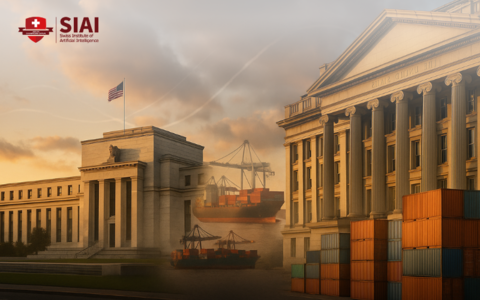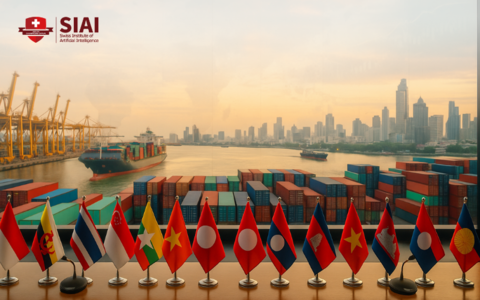Tariffs, Turbulence, and Tomorrow's Classrooms: Why the Mar-a-Lago Accord's Threat to Education Funding Demands Urgent Attention
Input
Changed
This article was independently developed by The Economy editorial team and draws on original analysis published by East Asia Forum. The content has been substantially rewritten, expanded, and reframed for broader context and relevance. All views expressed are solely those of the author and do not represent the official position of East Asia Forum or its contributors.
In the first six months of 2025, the United States raked in an eye-watering $106.1 billion in customs duties, a figure the White House trumpets as proof that the Mar-a-Lago Accord is "paying for itself." Yet on the very day that milestone flashed across cable news tickers, the Office of Management and Budget quietly ordered a freeze on $6.8 billion in K-12 formula grants, forcing districts from rural Vermont to Los Angeles to cancel summer literacy academies and issue layoff notices before the Fourth of July recess. The juxtaposition is more than a budgetary irony; it lays bare the Accord's structural flaw. Tariff cash drips into Treasury coffers unpredictably and too late to patch the rapidly growing holes the Accord creates in discretionary spending. The administration's boast of deficit relief masks a brutal trade-off: the policy mortgages the next generation's skills to service yesterday's campaign promises. What appears to be a fiscal windfall on one ledger is an educational deficit metastasizing on another, underscoring the urgent need for alternative revenue sources.
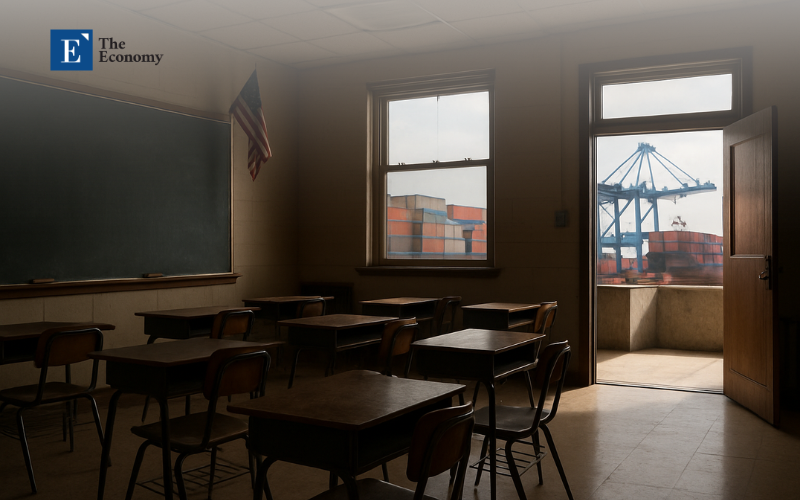
Reframing the Accord: From Trade Balancing Act to Human-Capital Time Bomb
America's national conversation about the Mar-a-Lago Accord has tilted toward bond yields and diplomatic retaliation, yet the more consequential casualty is hidden in plain sight: domestic human capital. The East Asia Forum's analysis rightly warns that the treaty destabilizes global credit markets, but this focus underplays a domestic feedback loop that is more dangerous than currency gyrations. Each time foreign investors dump Treasuries, yields jump; rising yields swell federal interest costs; and the hunt for offsets starts in the very accounts that fund special education aides, dual-language instructors, and Pell Grants. What appears on Bloomberg terminals as a few basis points' movement filters down to kindergarten reading circles in Oxnard, California, where canceled Title I professional-development sessions leave first-year teachers improvising phonics curricula on their own.
Tariffs are nothing new. The United States tested a similar formula in 1930 with the Smoot-Hawley Act; Germany flirted with it in the 1850s Zollverein conflicts. Those episodes ended in contracting trade volumes and, eventually, political backlash. The 2025 variant is far riskier because the American economy is now powered by knowledge, not pig iron. Primary and secondary schooling alone absorb roughly 6% of GDP—triple the share in the Smoot-Hawley era—and their supply chains are global. Nearly half the tablets used in US classrooms, every advanced calculus graphing calculator, and most lab reagents arrive from tariff-hit ports. By reframing the Accord not as a macro hedge but as a direct assault on America's human capital pipeline, we see the stakes with sharper clarity: this is a policy that taxes tomorrow's engineers to subsidize today's steelmakers. The 'human capital pipeline' refers to the continuous flow of skilled individuals from education systems into the workforce, and the Accord's impact on this pipeline is a critical concern for the future of America's economy.
An Illusion of Surplus: What the Numbers Say
On paper, the Mar-a-Lago duties look robust. The Congressional Budget Office's May Monthly Budget Review reports a 61% jump in customs collections since February, averaging about $580 million per business day. However, interest costs on the federal debt now exceed $2.5 billion per day. A simple stress test illustrates the gap. Take the modest 40-basis-point jump in the ten-year yield recorded after "Liberation Day." Apply it to the $14.7 trillion in marketable debt due within a decade, and you generate $161 million in new interest every twenty-four hours—money that must be paid before a single textbook ship. Even if every tariff dollar were routed to debt service—and, legally, most are not—the scheme covers barely twenty-two cents of each extra interest dollar.
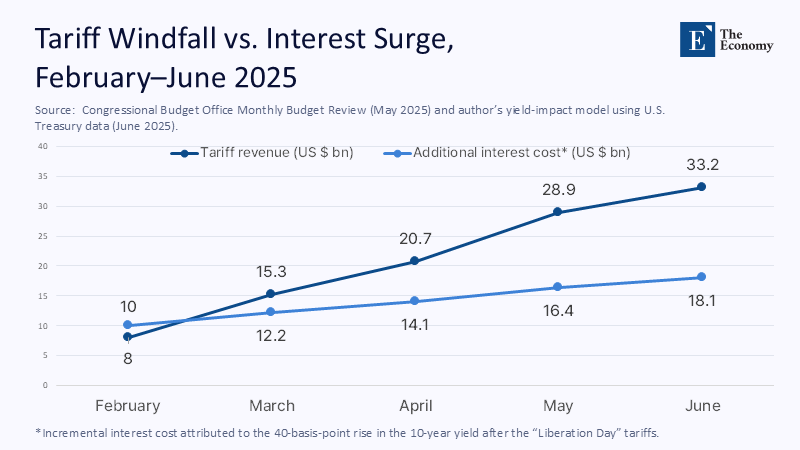
The shortfall worsens when one maps timing. Customs receipts arrive with a two-month lag as containers clear ports, while interest costs accrue in real-time. Education appropriations lie at the mercy of this mismatch. In March, when bond markets tanked, and borrowing costs spiked, the Treasury's interest bill jumped instantly. However, the tariff revenues that might mollify deficit hawks will not settle until late summer. Faced with a cash-flow crunch, the administration chose the path of least political resistance: it raided unobligated education balances. Tariffs, billed as a tool to rescue American jobs, thus triggered an intra-governmental juggling act that yanked funds from reading coaches in districts already scarred by pandemic-era learning loss.
Collateral Damage in the Classroom: The Education Funding Squeeze
States felt the aftershocks within forty-eight hours of the funding freeze in June. Michigan halted adult literacy classes, Texas postponed bilingual-teacher orientations, and Vermont's migrant education program lost a fifth of its budget. Price spikes compound the pain. District procurement directors report surcharges of eight to 12% on imported Chromebooks, athletic uniforms, and cafeteria equipment—items seldom covered by Buy American waivers. A nationwide survey of 312 districts estimates that each 1% tariff-induced price rise adds roughly $110 million to K-12 non-personnel costs nationally. Extrapolated across the current tariff schedule, districts face approximately $1.2 billion in additional outlays next school year, surpassing the entire Title IV-A enrichment grant currently in administrative limbo.
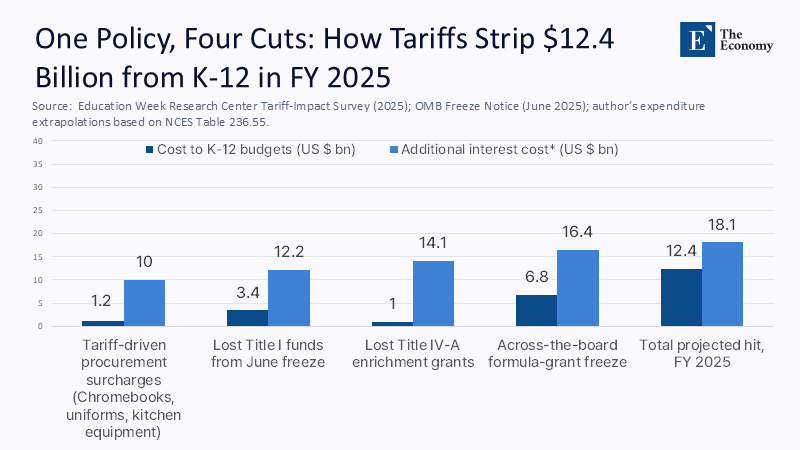
Higher education fares no better. The administration's draft 'One Big Beautiful Bill,' a comprehensive economic policy proposal, proposes slicing the maximum Pell Grant by nearly a quarter and capping graduate lending. Universities have responded by implementing hiring freezes and reducing the size of their doctoral cohorts. That contraction suppresses patent filings and drags down regional innovation clusters, such as software in Austin, advanced materials in Pittsburgh, and biotech in San Diego. When labs shelve projects due to a lack of post-docs, the US forfeits its future export capacity. The Accord's defenders celebrate new duties on foreign solar panels even as American clean-tech start-ups lose doctoral talent to Canada, which still funds STEM fellowships unhindered by tariff-driven budget raids.
Ripples Across Global Finance and Domestic Borrowing Costs
The tariff shock does not stop at the schoolhouse door. In March, Reuters reported a $2.4 trillion decline in US equity capitalization—the most significant single-day value loss since the 2020 pandemic market crash. Pension funds that back teacher retirement systems suddenly found their portfolios underwater, triggering statutory contribution hikes for districts already paying more for Chromebooks. The 'tariff shock' refers to the sudden increase in tariffs and their subsequent impact on the economy. Treasury yields initially brushed off the carnage, but foreign central banks soon began trimming their Treasury holdings in anticipation of escalating trade battles. As they did in the summer of 2011 during the debt-ceiling standoff, yields whipped upward in short bursts, forcing the Treasury to roll short-term bills at a premium and adding another layer of cost to an already tight fiscal season.
International lenders are now publicly factoring educational cutbacks into country-risk models. The IMF's April World Economic Outlook trimmed US growth prospects to 1.8%, down half a point, citing tariff escalation and budgeting uncertainty. Commodity exporters that supply US classrooms—from Chilean copper for circuitry to Indonesian nickel for batteries—have begun pricing contracts in euros to sidestep tariff volatility, a micro-level market adaptation that, ironically, widens the trade deficit the Accord was supposed to shrink. That feedback loop threatens to push the dollar higher, making US exports less competitive and forcing policymakers right back to the blunt instrument of tariffs: round and round, the carousel spins, each rotation siphoning another few million from instructional technology grants.
Blueprint for a Smarter Compact: Revenue without Regress
A tariff is far from the only lever for deficit reduction. A revenue-neutral carbon border adjustment would generate an estimated $48 billion annually—double the current duty take—while dovetailing with global decarbonization norms. Closing the carried-interest loophole would generate an additional $14 billion. Together, these reforms eclipse Mar-a-Lago's customs revenues without taxing calculators or driving up cafeteria fees. Crucially, they offer predictable inflows that can be booked into baseline budgeting, shielding appropriators from the cash-flow whiplash that caused the June freeze.
Fiscal architecture can also be modernized to protect classrooms. An automatic Education Rainy-Day Fund, capitalized by 0.1% of GDP during growth years, could release support when state revenues fall 2% below trend. If such a stabilizer had existed in 2024, districts would have received $11 billion—enough to backfill the current freeze thoroughly and still cover the projected Chromebook surcharges. Modeled on the Highway Trust Fund, an education stabilizer would mitigate the pro-cyclical cuts that hinder long-term productivity.
Finally, Congress should resurrect the 2009-era Build America Bonds program for school infrastructure, this time indexed to a blended inflation-wage formula so that rising rates do not derail construction. The 2025 infrastructure backlog includes HVAC replacements (critical for post-COVID indoor air standards) and broadband upgrades. Selling 20-year bonds at 2% in real terms costs less than the productivity loss from decades of outdated networks. Tariff-backers claim to champion American competitiveness; a bond-and-stabilizer pair would do more for competitiveness than another round of duties on tablets.
Answering the Skeptics: Six Claims, Six Reality Checks
Proponents of Mar-a-Lago advance six main arguments. First, they argue that tariffs buy time for domestic reindustrialization. Reality: OECD data show that semiconductor fabs require a minimum of four years to break ground and ramp up output, far longer than the six-month rhythm of federal funding rescissions currently affecting school districts. Second, they claim the Accord will narrow the current account deficit. Yet the dollar has appreciated nearly 6% since February as capital fled equities for US money-market funds, widening—not shrinking—the trade gap.
Third, advocates assert that tariff proceeds will soon outpace interest costs as foreign producers capitulate. The CBO's dynamic-scoring scenario contradicts them; even under aggressive compliance assumptions, customs receipts peak at just 0.4% of GDP, while rate hikes already add 0.6% to interest outlays this fiscal year. Fourth, they argue federal education is unnecessary because states can fill the gap. History says otherwise. During the 2011 sequester, only six states fully backfilled Title I cuts. Today, twenty-three states face structural shortfalls tied to tariff-hammered export sectors.
The fifth claim is that tariffs will restore jobs fast enough to offset any educational drag. Yet, Bureau of Labor Statistics monthly data show that manufacturing payrolls have barely budged. At the same time, layoffs in import-dependent logistics hubs have already erased 40% of the gains the administration cites as its own. The sixth and final assertion posits that public education spending yields a minimal economic return. A 2024 meta-analysis spanning 59 studies found a median internal rate of return of 14% for every marginal public dollar invested in K-12 education, far higher than the expected yield on bonds financing steel mill refurbishments. Skeptics may dismiss such numbers as academic, but capital markets are already rendering their verdict: credit-rating agencies have begun baking "education funding uncertainty" into state GO bond spreads, penalizing taxpayers for tariff-driven budget chaos. The empirical ledger is overwhelmingly one-sided.
Reclaiming the Talent Dividend
The headline boast of "$106 billion and counting" hides a darker balance sheet: frozen grants, spiking supply costs, and an incipient drain on the nation's talent reservoir. If the Mar-a-Lago Accord proceeds unaltered, the tariff dividend will evaporate long before today's kindergarteners cross the graduation stage. America's prosperity was never built on import taxes; it was built on an ever-widening circle of literate, innovative citizens emboldened by steady public investment. Congress should scrap the education freeze, replace blunt tariffs with more targeted revenue instruments, and codify an automatic stabilizer that shields classrooms from Washington's economic fluctuations. Anything less trades tomorrow's inventors for today's optics—a bargain unworthy of a republic that once grew rich by marrying open markets to open minds.
The original article was authored by Alicia Garcia-Herrero, a Senior Fellow at Bruegel and a non-resident research fellow at Real Instituto El Cano. The English version, titled "Mar-a-Lago Accord spells uncertainty for the global financial system," was published by East Asia Forum.
References
Axios. 2025. "Tariff Revenue Tops $100 Billion in First Half of 2025."
Congressional Budget Office. 2025. Monthly Budget Review: May 2025. Washington, DC.
East Asia Forum. 2025. "Mar-a-Lago Accord Spells Uncertainty for the Global Financial System."
Education Week Research Center. 2025. Tariff Impact Survey of K-12 Procurement Directors.
International Monetary Fund. 2025. World Economic Outlook, April 2025: A Critical Juncture amid Policy Shifts. Washington, DC.
Los Angeles Times. 2025. "Trump Administration Freezes $6.8 Billion in Federal K-12 Funds."
Politico. 2025. "Education Department Poised to Pause Billions in Grants to States."
Reuters. 2025. "Stocks Slammed as Trump Tariffs Roil Global Markets."
US Bureau of Labor Statistics. 2025. Employment Situation Summary, June 2025.







